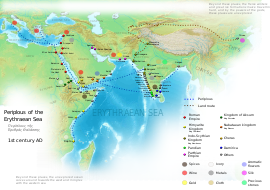| Ancient Malao | |
| Location | Berbera, Somaliland[1][2] |
| City-state existed: | 1st century AD |
Malao (Ancient Greek: Μαλαὼ)[3][4] was an ancient port city in present-day Somaliland. The town was situated on the site of what later would become the city of Berbera.[5] It was a key trading center involved in the Red Sea-Indian Ocean trade during Late Antiquity. The town maintained an important monetary market, exchanging goods in the currencies of the Roman Empire.[6]
History and trade
[edit]The ancient port city of Malao was positioned in the historic Somali city of Berbera. It is mentioned in the 1st century CE Periplus of the Erythraean Sea:
"After Avalites there is another market-town, better than this, called Malao, distant a sail of about eight hundred stadia. The anchorage is an open roadstead, sheltered by a spit running out from the east. Here the natives are more peaceable. There are imported into this place the things already mentioned, and many tunics, cloaks from Arsinoe, dressed and dyed; drinking-cups, sheets of soft copper in small quantity, iron, and gold and silver coin, not much. There are exported from these places myrrh, a little frankincense, (that known as far-side), the harder cinnamon, duaca, Indian copal and macir, which are imported into Arabia; and slaves, but rarely."
— Chap.8.[7]
Other than Arabia, goods were also purchased and transported to the Greek, Roman and Egyptian empires.[8] Malao gained its high level of trade from its nexus position, by being the closest African port to Arabia and the more peaceful nature of the city, as compared to other potential trade areas.[9]
See also
[edit]References
[edit]- ^ Chandra, S.; Jain, A. K. (2017-01-01). Foundations of Ethnobotany (21st Century Perspective). Scientific Publishers. p. 100. ISBN 978-93-87307-44-5.
- ^ Society, Hakluyt (1980). The Periplus of the Erythraean Sea. Ashgate Publishing, Ltd. p. 17. ISBN 978-0-904180-05-3.
- ^ "Περίπλους της Ερυθράς Θαλάσσης - Βικιθήκη". el.wikisource.org (in Greek). Retrieved 2022-05-29.
- ^ "ToposText". topostext.org. Retrieved 2022-05-29.
- ^ Allen, James De Vere (1993). Swahili Origins: Swahili Culture & the Shungwaya Phenomenon. J. Currey. p. 64. ISBN 978-0-85255-075-5.
- ^ Ray, Himanshu Prabha (2003). The Archaeology of Seafaring in Ancient South Asia. Cambridge University Press. p. 209. ISBN 0-521-01109-4.
- ^ "Internet History Sourcebooks". sourcebooks.fordham.edu. Retrieved 2022-05-29.
- ^ Dumper, Michael (2007). Cities of the Middle East and North Africa: A Historical Encyclopedia. ABC-CLIO. ISBN 978-1-57607-919-5.
- ^ McLaughlin, Raoul (2014-09-11). The Roman Empire and the Indian Ocean: The Ancient World Economy and the Kingdoms of Africa, Arabia and India. Pen and Sword. ISBN 978-1-78346-381-7.
